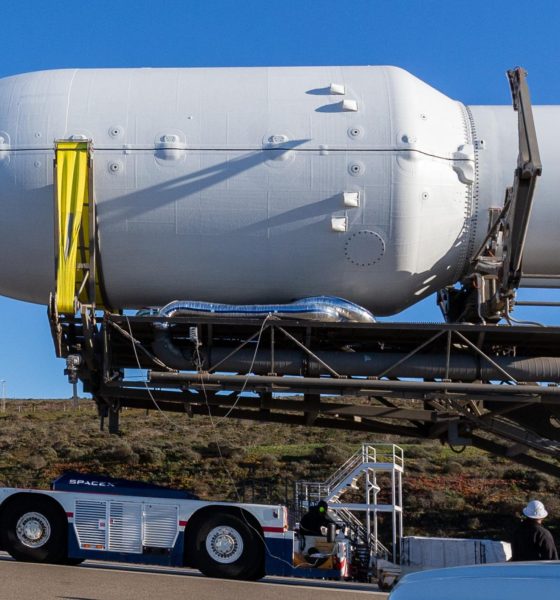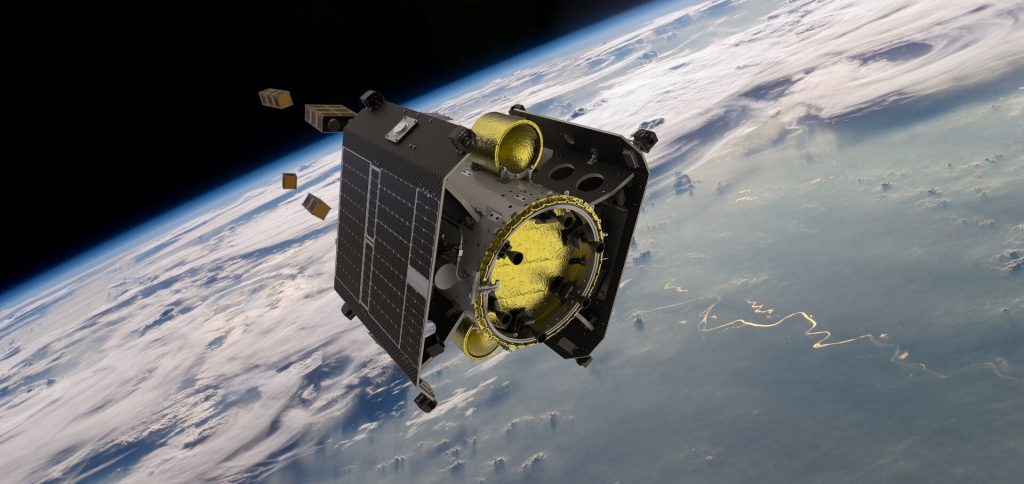

News
SpaceX delays Starlink doubleheader
Update: To “allow additional time for pre-launch checkouts,” SpaceX has delayed Starlink 2-6 from January 30th to 8:15 am PST (16:15 UTC), January 31st and Starlink 5-3 from February 1st to February 2nd.
A pair of SpaceX Falcon 9 rockets are on track to round out the first month of 2023 and kick off the second with a Starlink double-header.
“To complete pre-launch checkouts,” SpaceX delayed its last launch of the month by 24 hours. The first Falcon 9 rocket will launch Starlink 2-6 and a D-Orbit rideshare payload no earlier than 8:29 am PST (16:29 UTC) on Monday, January 30th. The mission will lift off from SpaceX’s Vandenberg Space Force Base (VSFB) SLC-4E pad and head southeast, skirting the California and Mexico coast. In case of bad weather or a minor technical issue, a backup window is available at 12:31 pm PST.
As few as 35.5 or 39.5 hours later, a second Falcon 9 rocket will lift off from SpaceX’s Florida-based NASA Kennedy Space Center LC-39A pad around 3:02 am EST (08:02 UTC) on Tuesday, February 1st.
The update that's rolling out to the fleet makes full use of the front and rear steering travel to minimize turning circle. In this case a reduction of 1.6 feet just over the air— Wes (@wmorrill3) April 16, 2024
Starlink 2-6
Kicking off the pair, Starlink 2-6 will be SpaceX’s ninth Starlink rideshare mission since the company began manifesting third-party payloads on its internet satellite launches in June 2020. Falcon 9 will launch the mission’s main payload – a batch of 49 Starlink V1.5 satellites – to a semi-polar orbit that will see them cross Earth’s equator at an angle of 70 degrees. Ordinarily, the mission would carry 51 Starlinks, but SpaceX has removed a pair of satellites to make room for Italian space logistics company D-Orbit’s ION SCV009 spacecraft.
ION weighs around 160 kilograms (350 lb) on its own and is roughly the size of a large oven. D-Orbit designed the spacecraft to host fixed payloads and deploy rideshare satellites in orbit. It also has a propulsion system that allows it to provide “last-mile delivery services,” offering rideshare customers the ability to tweak the orbit their satellite ends up in. Space tugs like ION aim to give satellite owners some of the benefits of a dedicated rocket launch (custom orbit selection in particular) while retaining most of the cost savings rideshare launches enable.

After reaching orbit, Falcon 9 will deploy ION first, use thrusters to spin itself end over end, and then release all 49 Starlink satellites simultaneously. The spinning stage’s centrifugal force causes the satellite stack to naturally spread out within several hours. The satellites then use reaction wheels to stabilize their orientation, deploy solar panels to begin charging their batteries, and eventually use ion thrusters to climb to operational orbits.
ION SCV009 will attempt to test a new satellite separation system built by EBAD and demonstrate its ability to operate in very low Earth orbit (VLEO). The spacecraft will potentially lower itself to an altitude of 270 kilometers (170 mi).
Starlink 5-3
Starlink 5-3 will carry no rideshare payloads and will likely be nearly identical to Starlink 5-2, which SpaceX successfully launched on January 26th. The latest mission’s stack of 56 Starlink V1.5 satellites weighed 17.4 tons and was the heaviest payload SpaceX has ever launched. Starlink 5-3 is targeting the same orbit and will likely also carry 56 satellites.
Pad 39A last supported SpaceX’s fifth Falcon Heavy launch on January 15th and has been quickly converted back to its single-core Falcon 9 configuration for Starlink 5-3. After the Starlink mission, Pad 39A has at least two Dragon spacecraft launches scheduled before SpaceX will need to convert it back to a triple-booster configuration for Falcon Heavy’s sixth launch.
SpaceX is scheduled to launch Crew Dragon’s Crew-6 astronaut transport mission no earlier than February 26th, and Cargo Dragon’s Spx-27 cargo delivery mission on March 11th. Falcon Heavy is scheduled to launch the giant ViaSat-3 communications satellite no earlier than March 24th.
Tune in below around 8:25 am PST (16:25 UTC) to watch SpaceX Starlink 2-6 launch live.

News
Tesla FSD fleet is nearing 7 billion total miles, including 2.5 billion city miles
As can be seen on Tesla’s official FSD webpage, vehicles equipped with the system have now navigated over 6.99 billion miles.

Tesla’s Full Self-Driving (Supervised) fleet is closing in on almost 7 billion total miles driven, as per data posted by the company on its official FSD webpage.
These figures hint at the massive scale of data fueling Tesla’s rapid FSD improvements, which have been quite notable as of late.
FSD mileage milestones
As can be seen on Tesla’s official FSD webpage, vehicles equipped with the system have now navigated over 6.99 billion miles. Tesla owner and avid FSD tester Whole Mars Catalog also shared a screenshot indicating that from the nearly 7 billion miles traveled by the FSD fleet, more than 2.5 billion miles were driven inside cities.
City miles are particularly valuable for complex urban scenarios like unprotected turns, pedestrian interactions, and traffic lights. This is also the difference-maker for FSD, as only complex solutions, such as Waymo’s self-driving taxis, operate similarly on inner-city streets. And even then, incidents such as the San Francisco blackouts have proven challenging for sensor-rich vehicles like Waymos.
Tesla’s data edge
Tesla has a number of advantages in the autonomous vehicle sector, one of which is the size of its fleet and the number of vehicles training FSD on real-world roads. Tesla’s nearly 7 billion FSD miles then allow the company to roll out updates that make its vehicles behave like they are being driven by experienced drivers, even if they are operating on their own.
So notable are Tesla’s improvements to FSD that NVIDIA Director of Robotics Jim Fan, after experiencing FSD v14, noted that the system is the first AI that passes what he described as a “Physical Turing Test.”
“Despite knowing exactly how robot learning works, I still find it magical watching the steering wheel turn by itself. First it feels surreal, next it becomes routine. Then, like the smartphone, taking it away actively hurts. This is how humanity gets rewired and glued to god-like technologies,” Fan wrote in a post on X.
News
Tesla starts showing how FSD will change lives in Europe
Local officials tested the system on narrow country roads and were impressed by FSD’s smooth, human-like driving, with some calling the service a game-changer for everyday life in areas that are far from urban centers.

Tesla has launched Europe’s first public shuttle service using Full Self-Driving (Supervised) in the rural Eifelkreis Bitburg-Prüm region of Germany, demonstrating how the technology can restore independence and mobility for people who struggle with limited transport options.
Local officials tested the system on narrow country roads and were impressed by FSD’s smooth, human-like driving, with some calling the service a game-changer for everyday life in areas that are far from urban centers.
Officials see real impact on rural residents
Arzfeld Mayor Johannes Kuhl and District Administrator Andreas Kruppert personally tested the Tesla shuttle service. This allowed them to see just how well FSD navigated winding lanes and rural roads confidently. Kruppert said, “Autonomous driving sounds like science fiction to many, but we simply see here that it works totally well in rural regions too.” Kuhl, for his part, also noted that FSD “feels like a very experienced driver.”
The pilot complements the area’s “Citizen Bus” program, which provides on-demand rides for elderly residents who can no longer drive themselves. Tesla Europe shared a video of a demonstration of the service, highlighting how FSD gives people their freedom back, even in places where public transport is not as prevalent.
What the Ministry for Economic Affairs and Transport says
Rhineland-Palatinate’s Minister Daniela Schmitt supported the project, praising the collaboration that made this “first of its kind in Europe” possible. As per the ministry, the rural rollout for the service shows FSD’s potential beyond major cities, and it delivers tangible benefits like grocery runs, doctor visits, and social connections for isolated residents.
“Reliable and flexible mobility is especially vital in rural areas. With the launch of a shuttle service using self-driving vehicles (FSD supervised) by Tesla in the Eifelkreis Bitburg-Prüm, an innovative pilot project is now getting underway that complements local community bus services. It is the first project of its kind in Europe.
“The result is a real gain for rural mobility: greater accessibility, more flexibility and tangible benefits for everyday life. A strong signal for innovation, cooperation and future-oriented mobility beyond urban centers,” the ministry wrote in a LinkedIn post.
News
Tesla China quietly posts Robotaxi-related job listing
Tesla China is currently seeking a Low Voltage Electrical Engineer to work on circuit board design for the company’s autonomous vehicles.

Tesla has posted a new job listing in Shanghai explicitly tied to its Robotaxi program, fueling speculation that the company is preparing to launch its dedicated autonomous ride-hailing service in China.
As noted in the listing, Tesla China is currently seeking a Low Voltage Electrical Engineer to work on circuit board design for the company’s autonomous vehicles.
Robotaxi-specific role
The listing, which was shared on social media platform X by industry watcher @tslaming, suggested that Tesla China is looking to fill the role urgently. The job listing itself specifically mentions that the person hired for the role will be working on the Low Voltage Hardware team, which would design the circuit boards that would serve as the nervous system of the Robotaxi.
Key tasks for the role, as indicated in the job listing, include collaboration with PCB layout, firmware, mechanical, program management, and validation teams, among other responsibilities. The role is based in Shanghai.
China Robotaxi launch
China represents a massive potential market for robotaxis, with its dense urban centers and supportive policies in select cities. Tesla has limited permission to roll out FSD in the country, though despite this, its vehicles have been hailed as among the best in the market when it comes to autonomous features. So far, at least, it appears that China supports Tesla’s FSD and Robotaxi rollout.
This was hinted at in November, when Tesla brought the Cybercab to the 8th China International Import Expo (CIIE) in Shanghai, marking the first time that the autonomous two-seater was brought to the Asia-Pacific region. The vehicle, despite not having a release date in China, received a significant amount of interest among the event’s attendees.








